Achieving meaningful goals takes more than intent—it requires a structured framework that works across the entire company. While KPIs and SMART goals focus on tracking or defining objectives, OKRs (Objectives and Key Results) are built to align efforts, focus on measurable outcomes, and inspire progress through stretch goals.
This guide covers everything you need to know about OKRs. Learn what they are, how they work at company, team, and individual levels, and why they’re essential for aligning quarterly objectives with long-term strategies. You’ll also find examples of company OKRs, team OKRs, and individual goals to guide your process.
What are objectives and key results (OKRs)?
Objectives and key results (OKRs) help organizations set goals and measure progress. Introduced by Intel CEO Andy Grove in the 1970s, this framework connects goals across company levels, from leadership to team OKRs and individual goals. Companies like Google, Disney, and Amazon use OKRs to focus on stretch goals, align efforts, and track results through regular check-ins.
What are objectives?
Objectives are statements that describe what a company, team, or individual wants to achieve. These are designed to inspire focus and connect efforts to a common goal. Objectives answer the question: Where do we want to go?
Examples of objectives:
- Improving customer satisfaction at a company level
- Driving sustainability initiatives at a team level
- Strengthening leadership skills at an individual level
What are key results?
Key results are specific, measurable targets that show how progress toward the objective will be tracked. They provide clarity for teams and individuals by defining the metrics that matter.
Examples of key results:
- Increase Net Promoter Score (NPS) to 60+ for a company-wide objective
- Launch in three new global markets by Q3 as a team OKR
- Complete two leadership courses within the quarter for an individual goal
OKRs create alignment across all levels of an organization, helping teams focus on quarterly objectives while tracking long-term goals through measurable results.
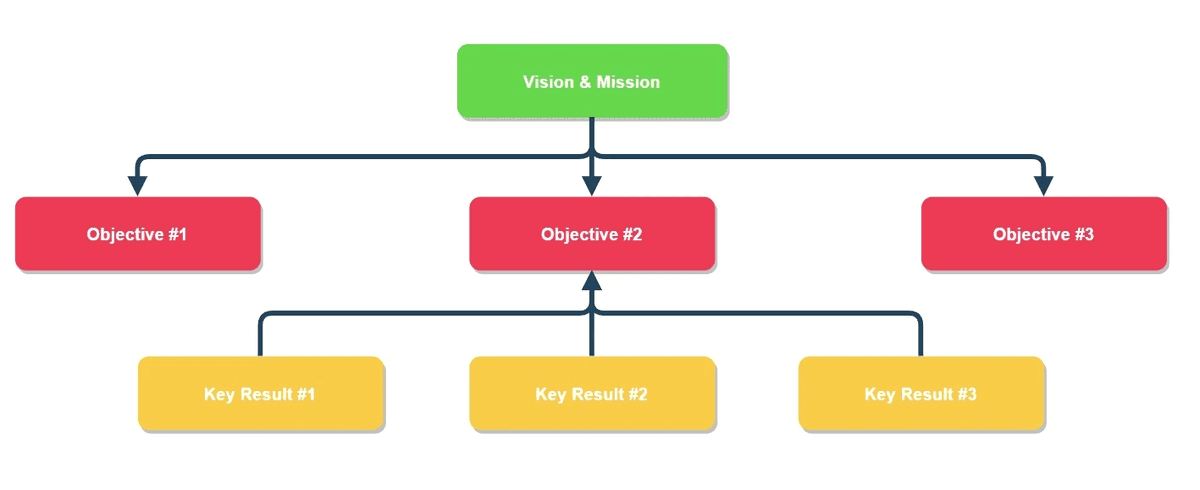
What’s the difference between KPI and OKR?
KPIs are metrics used to track specific areas of performance, such as sales growth or customer retention, while OKRs provide a more comprehensive framework for achieving goals. For example:
- A KPI might track sales revenue growth over time.
- An OKR would include a clear objective, such as improving global sales, with measurable key results like increasing revenue by 25% and expanding into three new markets.
KPIs often monitor ongoing performance, while OKRs focus on quarterly objectives that drive meaningful change.
Further reading: OKR vs. KPI – similarities and differences
Transitioning to OKRs
Switching from KPIs or SMART goals to OKRs helps align goals at every company level with clear, measurable outcomes. Here’s how to start:
- Evaluate current frameworks: Identify areas where alignment, tracking, or goal clarity could improve.
- Start small: Pilot the OKR process with one team, focusing on quarterly objectives and measurable key results.
- Track progress: Use tools like monday work management for regular check-ins and adjustments.
- Expand gradually: Roll out OKRs across the entire company, refining the approach through feedback.
- Review and adapt: Analyze successes and challenges to improve future cycles.
History & origin of OKRs
OKRs were introduced in the 1970s by Intel CEO Andy Grove, who created the framework to align high-level company goals with actionable results. John Doerr, a former Intel executive, brought OKRs to Google in the late 1990s. Since then, the framework has been adopted by organizations across industries, from startups to global enterprises, to connect teams and achieve measurable outcomes.
6 types of OKRs
OKRs are a structured framework that supports a wide range of business objectives. Each type serves a distinct purpose, helping organizations create an action plan that aligns with their company strategy and engages key stakeholders. Whether focusing on team-level goals or individual goals, OKRs help align priorities over a defined time frame.
1. Committed OKRs
Committed OKRs focus on realistic goals that teams fully intend to achieve within a specific period of time. These objectives often require resource allocation and contribute directly to critical business outcomes.
Example objective: Reduce customer churn by Q2.
Key results:
- Decrease churn from 15% to 10%.
- Increase active users by 20%.
- Launch a loyalty program in two regions by Q3.
2. Aspirational OKRs
Aspirational OKRs involve audacious goals that challenge teams to think beyond immediate possibilities. While full completion may not always occur, these goals encourage innovation and often lead to substantial progress.
Example objective: Become the global leader in renewable energy.
Key results:
- Source 100% of materials from renewable resources by 2026.
- Cut supply chain carbon emissions by 70%.
- Achieve carbon neutrality by 2030.
3. Learning OKRs
Learning OKRs prioritize exploration and gaining new knowledge. These objectives are especially useful for testing strategies or entering uncharted areas.
Example objective: Explore customer preferences in emerging markets.
Key results:
- Conduct interviews with 100 customers in two regions.
- Pilot a product line based on local tastes.
- Run a test campaign to evaluate sales potential.
4. Top-down OKRs
Top-down OKRs originate at the leadership level, providing a clear direction for teams across the organization. These objectives help align quarterly objectives and drive progress toward company-wide goals.
Example objective: Expand global market share.
Key results:
- Enter five new countries by year-end.
- Launch a global advertising campaign in Q3.
- Boost international revenue by 15%.
5. Bottom-up OKRs
Bottom-up OKRs empower teams or individuals to create goals that connect to broader company objectives. This collaborative approach helps relevant teams contribute meaningfully to the common goal.
Example objective: Improve the onboarding experience for new employees.
Key results:
- Cut onboarding time from 20 days to 15 days.
- Raise satisfaction scores to 90%.
- Launch a self-service onboarding portal by Q3.
6. Personal OKRs
Personal OKRs focus on individual goals that contribute to team and company outcomes. They encourage skill development and personal accountability.
Example objective: Strengthen leadership skills.
Key results:
- Complete two leadership training courses by quarter-end.
- Mentor three junior colleagues.
- Earn a 90% positive leadership review score.
Benefits of OKRs
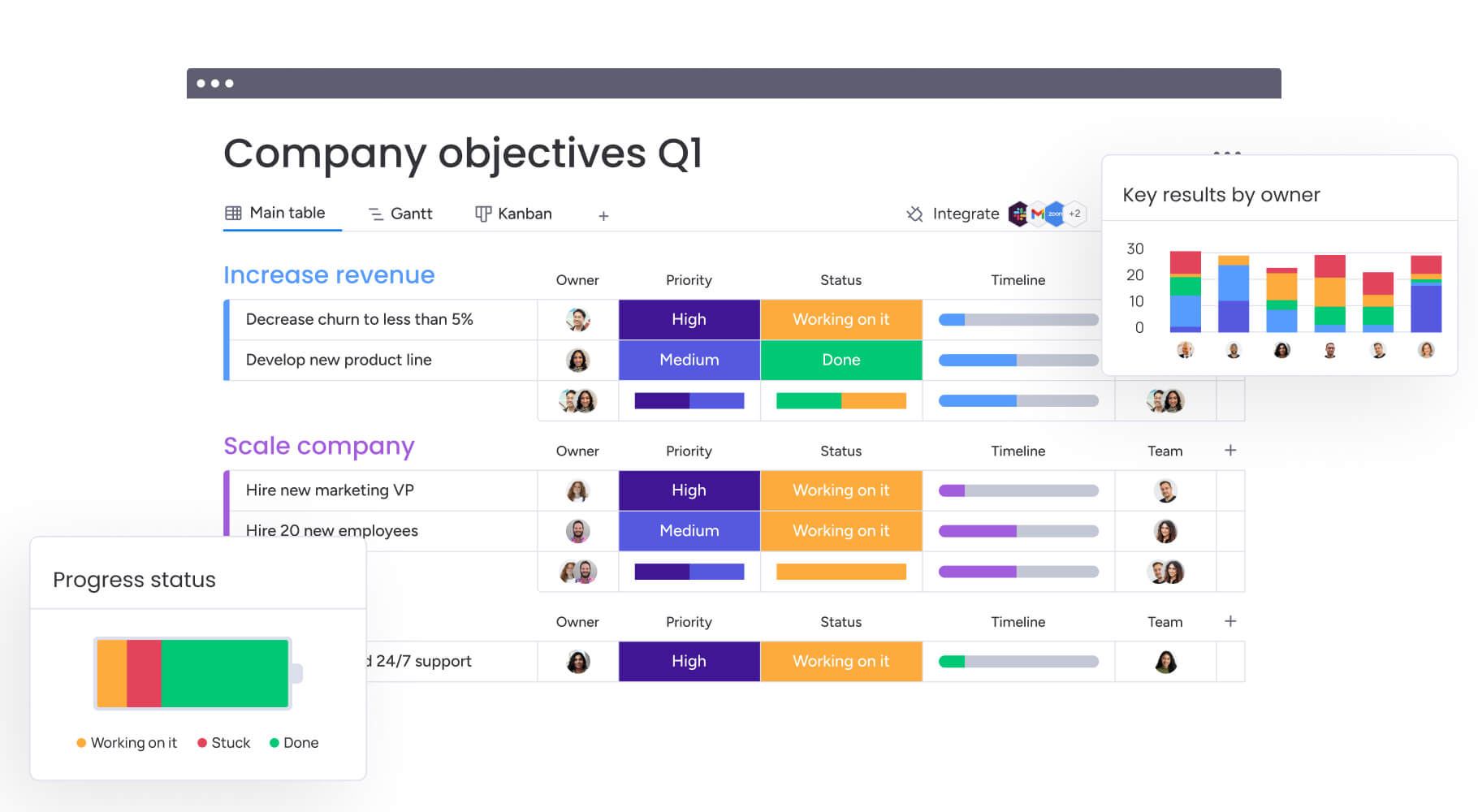
OKRs provide a structured way to achieve measurable results across all company levels. Their focus on stretch goals and alignment with quarterly objectives makes them a valuable framework for driving performance reviews, tracking progress, and achieving business outcomes.
Focus
OKRs limit objectives to a manageable number, helping teams concentrate on priorities within a given period of time.
Example:
A company improving customer satisfaction might focus on achieving an NPS of 60+ and reducing response times to under five minutes.
Alignment
OKRs link goals across the entire company, aligning individual goals, team OKRs, and company OKRs with the broader company strategy.
Example:
For a global expansion:
- Marketing focuses on international campaigns.
- Sales drives deals in new regions.
- Product teams localize the platform for new markets.
Commitment
OKRs assign ownership to relevant teams or individuals, creating accountability through regular check-ins and reviews.
Example:
A team launching a new product might track key results like meeting a 90% on-time delivery rate and collecting 10 customer testimonials post-launch.
Tracking
OKRs use clear metrics and defined time frames to monitor progress, helping teams make adjustments as needed.
Example:
A sustainability goal could include tracking metrics like reducing carbon emissions by 30% and achieving zero waste in offices by year-end.
Stretch goals
OKRs encourage teams to pursue audacious goals that inspire new strategies and innovation.
Example:
A technology company might aim for a 50% market share in five years, motivating teams to pursue creative solutions and bold initiatives.
Why are OKRs important for your business?
OKRs help organizations turn a company strategy into an actionable plan that aligns with business outcomes. They connect team leaders, key stakeholders, and individual contributors to a shared goal, creating a structured approach to tracking progress and achieving results.
Tools like monday work management simplify the process, helping teams create quarterly objectives, manage team OKRs, and conduct regular check-ins—all while keeping the entire company aligned and focused on measurable outcomes.
How to write OKRs
Creating OKRs requires thoughtful planning and collaboration. A well-defined OKR includes clear goals and measurable outcomes that guide progress week after week. Use this step-by-step guide to create impactful OKRs that align with actionable long-term projects and the company’s strategy.
Step 1. Start with objectives
Define what you aim to accomplish during the set period of time. Objectives should inspire progress and align with the broader planning process. They need to be clear, specific, and relevant to the team or company strategy. Avoid vague objectives that lack focus or fail to motivate.
Tips for writing objectives:
- Use action-oriented language like “Increase” or “Reduce.”
- Keep objectives concise and tied to a common goal.
- Ensure objectives connect directly to team or company priorities.
Example objective: Expand global market presence.
Step 2: Add key results
Key results translate the objective into measurable progress. They should be specific, time-bound, and designed to track week-to-week achievements. Break down ambitious goals into smaller, trackable milestones that fit the overall action plan.
Tips for writing key results:
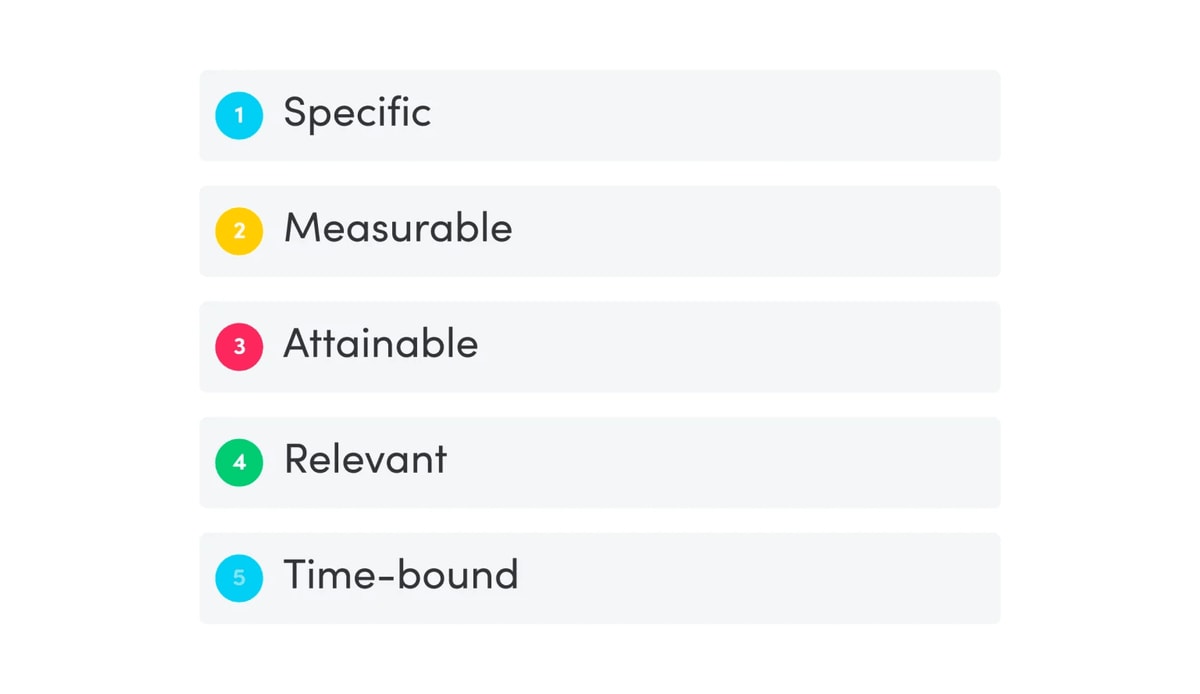
- Follow SMART criteria: Specific, Measurable, Achievable, Relevant, and Time-bound.
- Limit key results to 3–5 per objective to focus on priorities.
- Balance challenge and feasibility to hit the sweet spot for progress.
Example key results for “Expand global market presence”:
- Launch in three new markets by the 2nd week of Q3.
- Increase international revenue by 25%.
- Secure 10 new partnerships in Europe over the upcoming week.
Key results checklist:
- Is the result measurable?
- Does it include a defined timeline?
- Does the result directly support the objective?
Step 3: Review and refine
Share drafted OKRs with relevant teams or key stakeholders to align them with the broader planning process. Reviews ensure goals are realistic and tied to actionable long-term projects. Collaborative discussions during reviews often reveal areas for adjustment and improvement.
Key considerations during review:
- Are the objectives ambitious but achievable within the time frame?
- Are the key results realistic yet challenging enough to inspire progress?
- Do the OKRs connect with broader company or team goals?
Tools like monday work management simplify the review process, allowing teams to centralize feedback and refine objectives efficiently.
Step 4: Score and iterate
Regular check-ins are vital for evaluating OKR progress week after week. A scoring system provides insight into how well teams are meeting their goals and highlights areas for improvement. Scores typically range from 0.0 to 1.0:
- 0.0–0.3: Minimal progress.
- 0.4–0.6: Partial progress.
- 0.7–1.0: Significant progress or completion.
How scoring works:
- Assign a score to each key result based on the progress made.
- Calculate the average score for the entire objective project.
- Use these scores to adjust strategies and prepare for the next cycle.
Example scoring:
Objective: Expand global market presence.
- KR1: Launch in three new markets by Q3. Score: 0.7
- KR2: Increase international revenue by 25%. Score: 0.5
- KR3: Secure 10 new partnerships in Europe. Score: 0.8
Average Score for Objective: 0.67 (partial progress).
Reflect on each cycle to identify what worked, what didn’t, and what adjustments are needed for future OKRs.
Step 5: Connect OKRs to daily workflows
Integrate OKRs into the planning process and daily workflows to maintain consistent progress. Align individual tasks, team goals, and company objectives through real-time tracking tools.
Steps to connect OKRs with workflows:
- Use dashboards in platforms like monday work management to visualize progress week after week.
- Break down key results into daily tasks and assign them to team members.
- Align team meetings with weekly progress reviews to identify challenges and adjust plans.
- Incorporate workflow integrations with tools like Slack or Microsoft Teams to connect updates directly to the planning process.
When OKRs are tied to daily operations, teams can effectively work toward actionable long-term projects and stay aligned with the company’s strategy. Progress becomes part of the routine, driving results every week.
Examples of OKRs
Here’s a variety of OKR examples across different departments to help you get started and create clear, measurable goals tailored to your team’s needs:
Sales OKRs
| Objective | Key results |
|---|---|
| Lift monthly sales revenue | KR1: Increase the number of closed deals from 400 to 600. |
| KR2: Increase average subscription value to $750 per month. | |
| KR3: Lift demo-to-close rate from 50% to 60%. | |
| Speed up deal velocity | KR1: Hire 5 new salespeople to ensure new leads are promptly followed up. |
| KR2: Adjust email outreach campaigns from 7 steps over 32 days to 6 steps over 24 days. | |
| KR3: Reduce average days to close a deal from 66 to 54. |
Marketing OKRs
| Objective | Key results |
|---|---|
| Improve brand awareness | KR1: Secure 10 new earned media placements. |
| KR2: Publish 5 new blog posts to drive 3,000 unique visitors. | |
| KR3: Increase page one search results from 14 to 22. | |
| KR4: Boost brand awareness score from 42% to 60% in target demographics. | |
| Generate new leads | KR1: Increase the number of monthly leads from 1,200 to 1,600. |
| KR2: Double paid social media spend from $10,000 to $20,000. | |
| KR3: Ensure all top 100 ranking blog posts have compelling CTAs. |
HR OKRs
| Objective | Key results |
|---|---|
| Improve employee engagement | KR1: Achieve a weekly employee satisfaction score of 4+ over 90 days. |
| KR2: Launch a 360-degree feedback initiative with a 50% participation rate. | |
| Reduce employee turnover | KR3: Host a company-wide lunch event once per month. |
| KR1: Lower churn rate from 10% to 5%. | |
| KR2: Achieve an employee satisfaction score of 4+ across all departments. | |
| KR3: Align all salaries to meet or exceed industry averages. |
Product OKRs
| Objective | Key results |
|---|---|
| Enhance advanced feature adoption | KR1: Increase usage of advanced features by 10%. |
| KR2: Launch a marketing campaign to showcase advanced feature benefits. | |
| KR3: Redesign the GUI to make advanced features more accessible. | |
| Resolve product bugs faster | KR1: Reduce average bug resolution time from 33 to 26 days. |
| KR2: Hire 2 additional engineers to focus on bug resolution. | |
| KR3: Achieve a 90% resolution rate for high-priority tickets within SLA timelines. |
Admin OKRs
| Objective | Key results |
|---|---|
| Optimize supplier payment processes | KR1: Delegate payment management to a single admin assistant. |
| KR2: Implement an automated payment reminder system. | |
| KR3: Maintain $0 in late payment fees for three consecutive months. | |
| Create a desirable workplace environment | KR1: Conduct an employee feedback campaign with 80% participation. |
| KR2: Resolve the top 5 employee-identified workplace issues. | |
| KR3: Hold one employee appreciation event per quarter. |
Design OKRs
| Objective | Key results |
|---|---|
| Boost overall website conversion rates | KR1: Launch a new landing page designed to increase conversions. |
| KR2: Test 3 landing page designs with 150+ external users. | |
| KR3: Achieve a website-wide conversion rate increase from 20% to 30%. | |
| Improve visual content for marketing | KR1: Audit all existing content for visual improvements. |
| KR2: Hire a designer dedicated to marketing initiatives. | |
| KR3: Boost social content shares by 20%. |
Customer service OKRs
| Objective | Key results |
|---|---|
| Improve customer retention | KR1: Reduce call wait times to less than 5 minutes. |
| KR2: Lower churn rate from 10% to 5%. | |
| KR3: Hire 3 new service representatives to address customer issues faster. | |
| Increase customer satisfaction | KR1: Collect 2,000 responses to customer satisfaction surveys. |
| KR2: Identify 5 key areas for improvement. | |
| KR3: Conduct phone interviews with 100 top customers and 20 recently churned customers. |
How to avoid common OKR mistakes
While setting OKRs can help drive success, there are common pitfalls to watch for:
- Setting unrealistic objectives: Goals should challenge teams but still remain achievable. Overly ambitious objectives can lead to frustration and missed targets.
- Focusing solely on top-down objectives: Balance goals from leadership with bottom-up OKRs. Allow teams to propose objectives that align with their expertise and daily operations.
- Providing insufficient resources: Teams need the right time, tools, and personnel to achieve their goals. Without adequate support, even well-crafted OKRs may fall short.
- Writing vague OKRs: Objectives and key results should be clear, measurable, and actionable. Specificity helps teams focus on precise outcomes rather than broad intentions.
- Neglecting progress tracking: Regularly monitor progress using tools or meetings to discuss updates. Ignoring tracking can lead to roadblocks going unnoticed.
- Confusing OKRs with daily tasks: OKRs should reflect higher-level outcomes, while daily tasks act as steps to achieve those results. Keep the distinction clear.
- Focusing only on aspirational or operational goals: A mix of ambitious goals and practical objectives encourages innovation while addressing immediate priorities.
- Creating too many or too few objectives: Stick to 3–5 objectives per quarter to maintain focus and ensure teams aren’t overwhelmed or underutilized.

Dave continues – “In my experience working with multiple organizations, I have witnessed how OKRs can transform not only the way teams operate but also the culture of an organization. OKRs are built to align efforts more closely, inspire progress through stretched goals, and emphasize measurable outcomes.
This alignment can and should foster a sense of ownership and accountability among team members, motivating them to push beyond their own previous reach.
I’ve helped add OKRs in diverse organizations, within early stage startups up to larger organizations.
And by introducing OKRs, myself and the teams that I worked with were able to connect individual contributions to broader company objectives, which not only clarified priorities but also enhanced collaboration across departments. The impact has always been incredible. Teams became more focused on achieving ambitious targets that ultimately propelled the company forward.
An added bonus is that the iterative nature of OKRs always encourages continuous performance improvement. Regular check-ins allowed us to assess progress, and sometimes shortcomings, and make the necessary adjustments, allowing us to stay agile in a fast setting.
This experience always reinforces my belief that when organizations embrace a structured goal-setting framework like OKRs, they empower their teams to excel, which is all the better for the business.”
Dave Miller, Co-founder | purple path
How monday work management simplifies the OKR process
monday work management makes the OKR process simple and highly collaborative, providing tools to define, track, and achieve goals with confidence. Here’s how the platform supports OKR management:
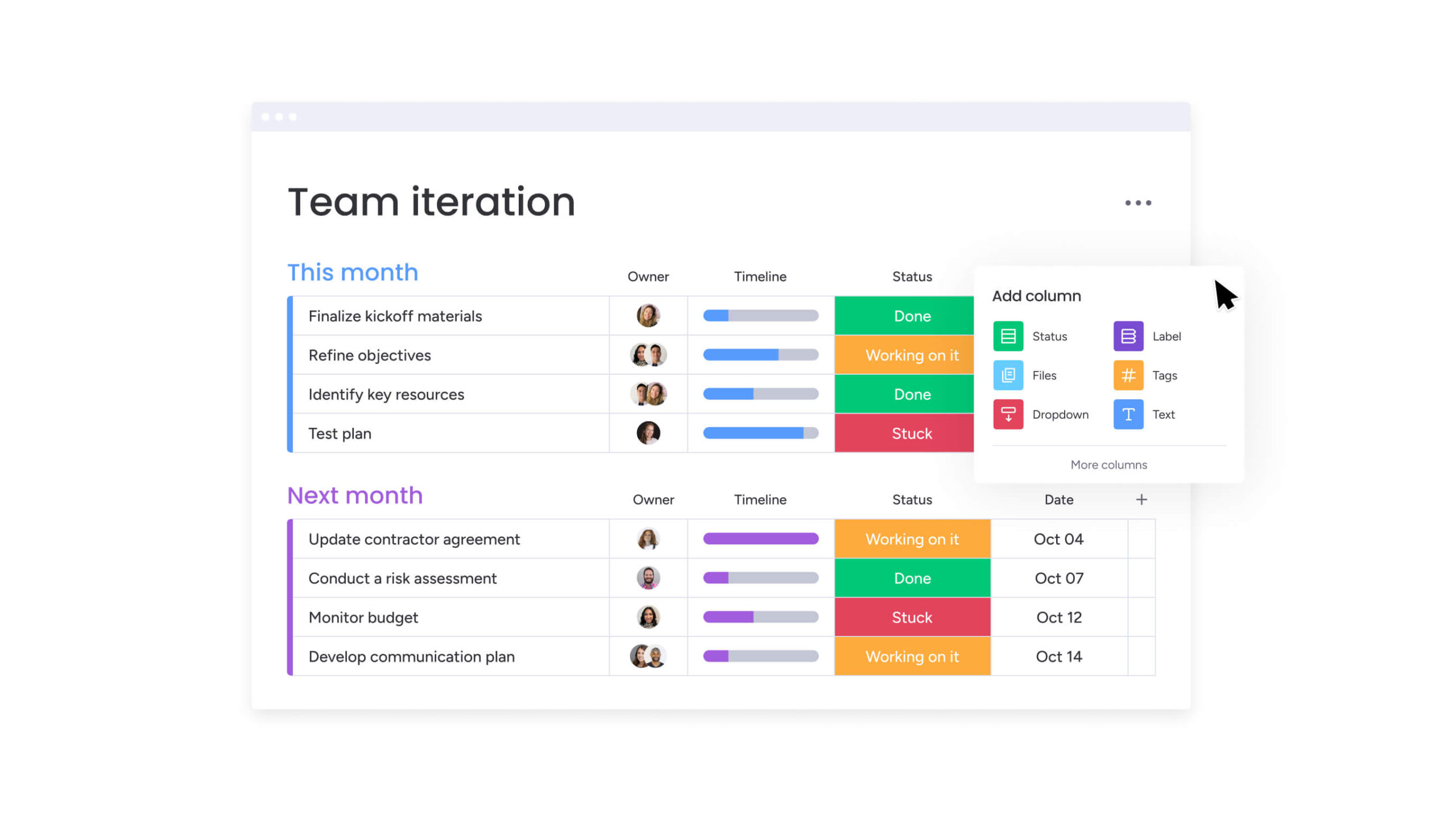
- Customizable templates: Start with ready-made templates that can be adjusted to fit your organization’s unique needs. These templates provide a clear structure for defining and organizing OKRs across teams.
- Visual dashboards for progress tracking: Monitor objectives and key results through real-time dashboards, timelines, and Gantt charts. These visual tools make it easy to stay updated and shift priorities when necessary.
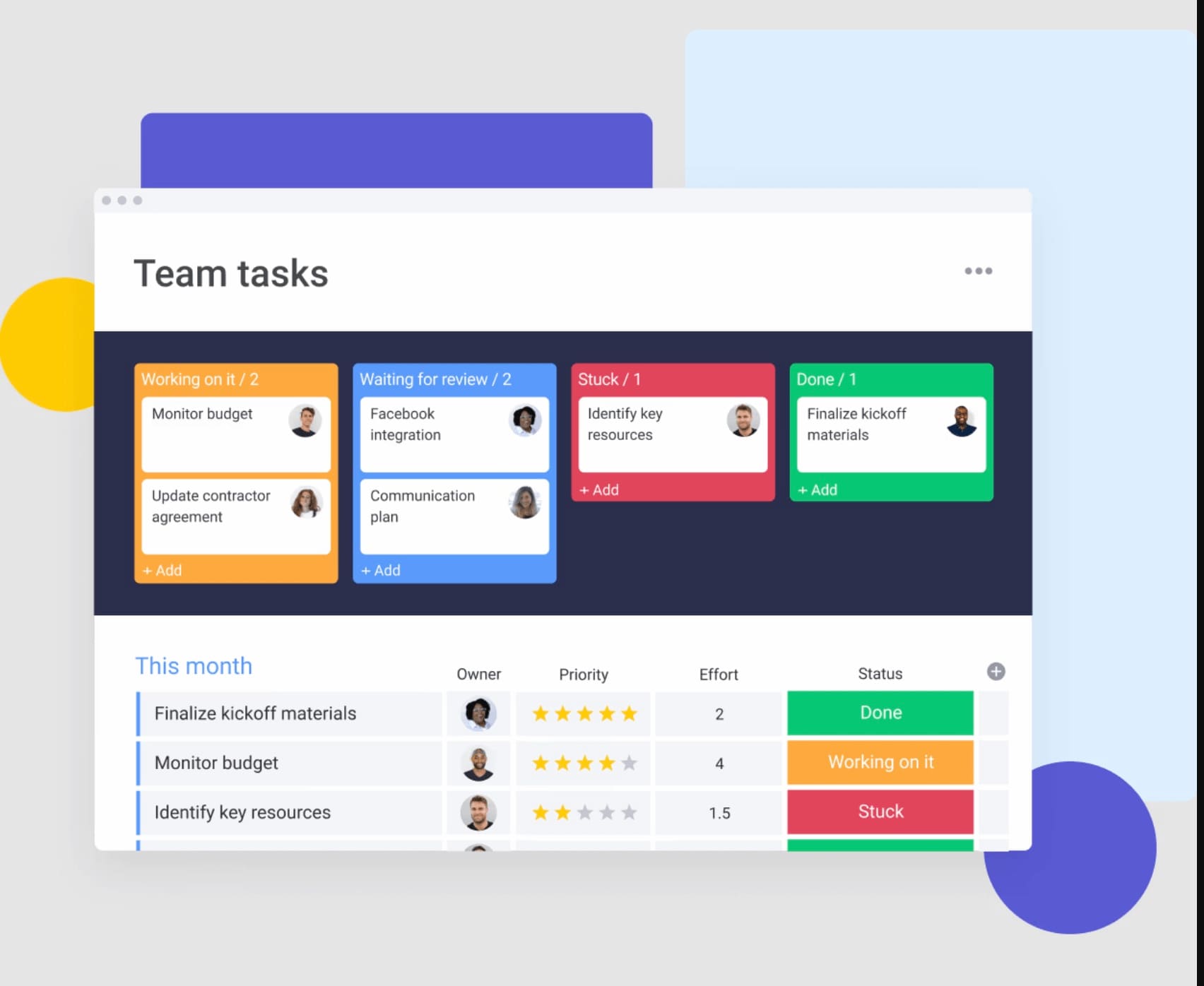
- Collaboration features: Assign ownership for key results and break them into actionable tasks. Shared workdocs, task assignments, and integrated communication tools help keep everyone aligned.
- Task automation: Save time by automating repetitive updates, reminders, or notifications. This allows teams to focus on their goals rather than manual tracking.
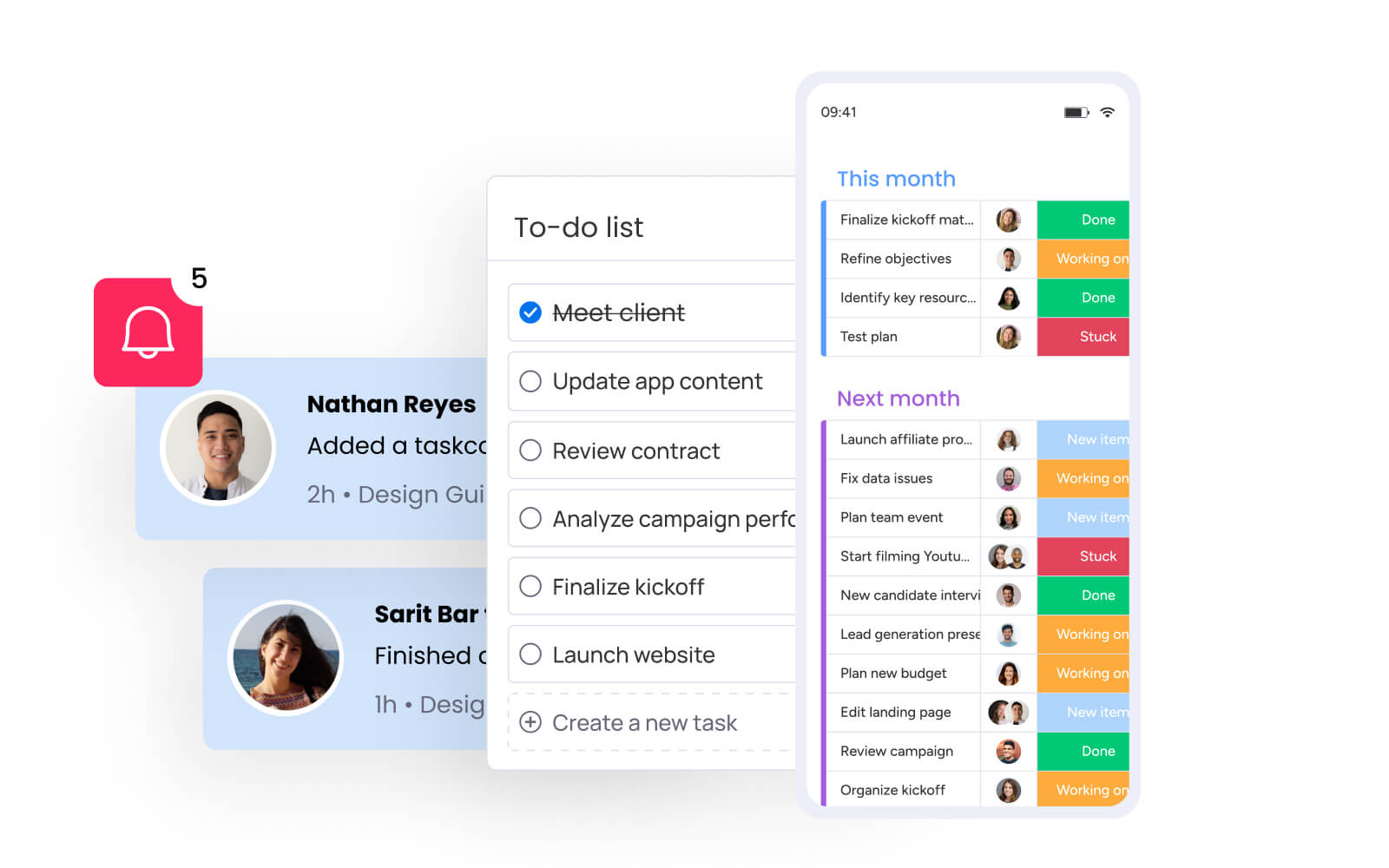
- In-depth reporting and analysis: Use reporting tools to evaluate performance, adjust strategies, and identify patterns that inform better decision-making for future OKRs.
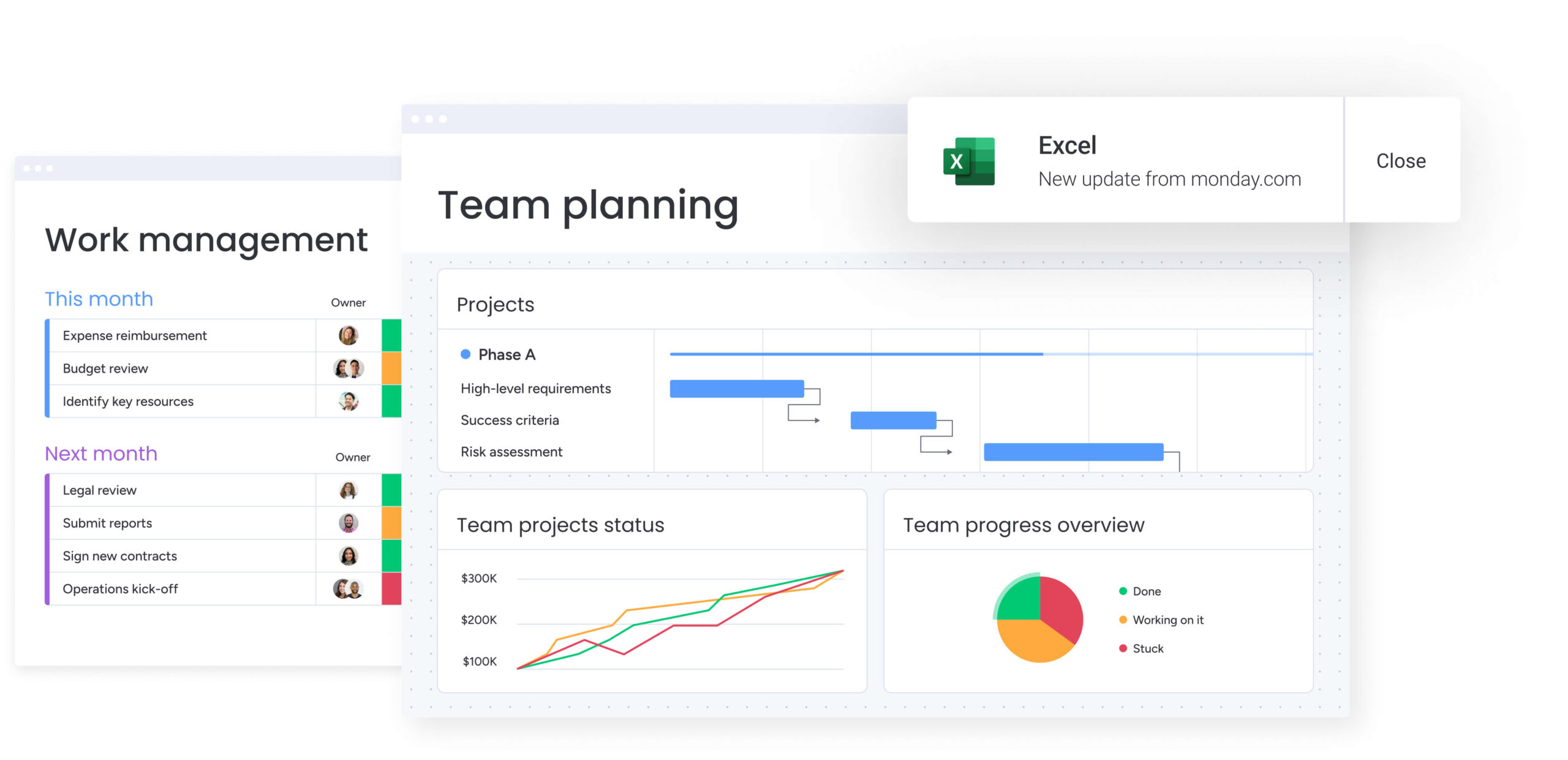
monday work management’s integrations with platforms like Slack and Microsoft Teams help bring OKRs into your daily operations. The design makes it easy for teams to adopt OKRs without unnecessary complexity. It balances functionality and ease of use, making it a great choice for organizations aiming to align goals with actionable progress.
OKR training
Training your team on how to create and manage OKRs helps build confidence and alignment across the organization. Here are some recommended training options:
- Measure What Matters by John Doerr: This training, based on the book, dives into OKR strategies with real-world examples from companies like Google and Intel. It’s great for leaders looking to adopt OKRs at scale. for leadership teams looking to drive alignment and focus across their organization.
- LinkedIn Learning: Goal Setting: Objectives and Key Results: A beginner-friendly course that explains the fundamentals of crafting effective OKRs, aligning team goals, and monitoring progress. Its short video lessons are ideal for busy schedules.
- Coursera: OKR Certification: Leadership and Goal Setting: A comprehensive course led by industry experts, covering everything from writing OKRs to integrating them into organizational strategies. Hands-on exercises help participants practice these concepts.
Drive focus and alignment with OKRs
OKRs go beyond goal-setting—they help teams focus, align efforts, and achieve measurable outcomes. Clear objectives paired with specific key results enable organizations to break ambitious goals into manageable steps, driving progress across all levels.
OKRs help teams prioritize what matters, align with company priorities, and deliver meaningful results. They support innovation while keeping everyone focused on shared goals, whether addressing short-term goals or working toward long-term aspirations.
Tools like monday work management make it easier to manage OKRs. Pre-built templates, real-time dashboards, and integrations allow teams to stay organized and track progress. With OKRs and the right tools, businesses can build accountability and improve performance for lasting success.
FAQs
What does OKR stand for?
OKR stands for Objectives and Key Results. This goal-setting process helps teams and organizations set clear objectives, measure outcomes, and track progress toward meaningful results. It fosters goal alignment across teams and supports both personal goals and company-wide OKRs.
How do you grade OKRs?
OKRs are graded on a scale from 0.0 to 1.0. A score of 0.3 indicates limited progress, while a score of 0.7 or higher represents significant achievements. This grading system provides insight into organizational performance, helping teams refine quarterly goals and improve alignment with organizational objectives.
How many OKRs should I set?
Most teams find success with 2–3 objectives per quarter, each tied to 3–5 key results. Keeping OKRs manageable supports proper alignment with broader company priorities and ensures teams stay focused on what matters most.
What are the 5 elements of OKRs?
The five elements of OKRs are focus, alignment, commitment, tracking, and stretching. These principles help create clear, measurable goals that inspire teams to achieve impactful outcomes.
How do I choose a good OKR?
A strong OKR connects directly to the organization’s strategy, includes measurable and time-bound key results, and balances realism with challenge. Whether it’s a lofty goal or an incremental objective, the focus should always remain on driving impactful progress.
What are some common misconceptions about OKRs?
One misconception is that OKRs are only suitable for large organizations. In reality, they work for teams of all sizes. Another is that achieving a perfect 1.0 score is essential. However, a score of 0.7 often reflects meaningful progress and highlights areas for improvement in future cycles.
Can OKRs support personal and company-wide goals?
Yes, OKRs work across all levels, from personal goals to company-wide OKRs. This flexibility allows teams and individuals to contribute to organizational objectives while focusing on their specific responsibilities. Proper alignment between personal and organizational goals ensures a cohesive effort toward achieving business outcomes.
How can OKRs improve organizational performance during a company trial?
During a company trial or pilot phase, OKRs offer a structured way to test the framework’s effectiveness. Start with quarterly goals focused on a single department or team, then scale based on the trial’s outcomes. Tracking progress during the trial allows for adjustments and refinement before rolling out OKRs across the entire organization.
 Get started
Get started 
